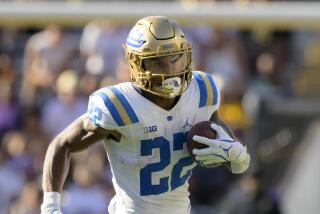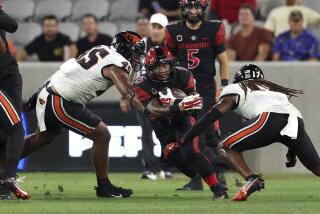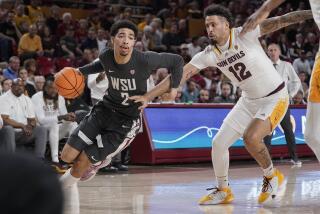COLLEGE FOOTBALL ’88 : Pacific 10 Preview : Everybody’s Trying to Catch Up With UCLA and USC, as Usual
- Share via
The Pacific 10 Conference isn’t generally labeled a two-team league in football, such as the Big Eight, where either Oklahoma or Nebraska routinely wins the championship.
Even so, USC and UCLA are generally favored to finish high in the standings, if not to win the title outright.
Nothing has changed this year. According to various publications and polls, the Trojans and Bruins are the teams to beat.
That isn’t surprising, considering that the Trojans and Bruins have won or shared the conference championship in 12 of the last 16 years.
There is also some support for Washington, which was dominant in the early 1980s. Arizona and Oregon are accorded outside chances of winning the championship, but form usually prevails.
This season also figures to be regarded as the year of the quarterback in the Pac-10. Nine of the 10 teams have their starting quarterbacks returning. Only Washington’s Cary Conklin is a relative newcomer.
Most prominent are USC’s Rodney Peete and UCLA’s Troy Aikman, who spent much of the off-season posing for magazine-cover pictures identifying them as Heisman Trophy candidates.
However, there are other quarterbacks of merit, namely Oregon’s Bill Musgrave and California’s Troy Taylor.
As for the conference race, it is expected to be close, with, perhaps, the schedule becoming a determining factor.
USC will play five of eight conference games on the road, two of them in Arizona with the Wildcats and Sun Devils.
UCLA is on the road for four of its conference games and will venture to Seattle to play Washington, usually formidable at home.
Washington’s season probably will hinge on three consecutive road games in October--Arizona State, USC and Oregon.
Arizona has a more comfortable schedule, playing six of its last seven conference games at home with USC, UCLA and Arizona State among the visitors.
A look at the Pac-10, excluding USC and UCLA:
ARIZONA
1987 records: 4-4-3 Overall, 2-3-3 Conference
1987 conference finish: 7th.
Last year, Dick Tomey’s first as Arizona’s coach, he introduced an offense that combined the wishbone and the run-and-shoot. Arizona was able to run, leading the conference in rushing, but there wasn’t much shooting--passing--after quarterback Bobby Watters suffered a broken thumb in the third game. His replacement, freshman Ronald Veal, was more comfortable running and set a school rushing record for a quarterback with 566 yards. Watters and Veal are in spirited competition for the starting job.
Otherwise, Tomey has experienced running backs, including Art Greathouse and Alonzo Washington; a big-play wide receiver in Derek Hill, and two-time All-Pac-10 center Joe Tofflemire. Tomey has apparently lost fullback Mario Hampton, who suffered a knee injury in practice.
Despite only five defensive starters returning--strong safety Chuck Cecil, Pac-10 defensive player of the year, the most notable absentee--Tomey fells he will have a good defense.
ARIZONA STATE
1987 records: 7-4-1 overall, 3-3-1 conference.
1987 conference finish: 4th
The Sun Devils will have to prove that they can survive serious losses in personnel. All-American guard Randall McDaniel, wide receiver Aaron Cox, defensive end Shawn Patterson, cornerback Eric Allen, tailback Darryl Harris and linebacker Greg Clark all have left, many of them as high pro draft choices. Moreover, Larry Marmie, the former defensive coordinator, succeeds John Cooper, who became Ohio State’s coach last January.
The offense will be directed by fifth-year senior quarterback Daniel Ford, who was benched on two occasions last year. He threw 12 touchdown passes and 15 interceptions. Tailback Victor Cahoon and fullback Kirk Wendorf, reserves last year, replace the two-year tandem of Harris and Channing Williams.
There is some concern on defense, since Saute Sapolu is the only returning starter in the line. Marmie, however, has punter Mike Schuh and kicker Alan Zendejas, whose older brothers, Luis and Max, were record breakers at Arizona State and Arizona, respectively.
CALIFORNIA
1987 records: 3-6-2 overall, 2-3-2 conference.
1987 conference finish: 8th.
The Bears have 19 starting players back, more than any other Pac-10 school. Yet, there is a contradiction. Coach Bruce Snyder, in his second season at Berkeley, is concerned about his team’s depth. For example, he doesn’t have any experienced backups behind quarterback Troy Taylor and tailback Chris Richards.
Richards, bothered by an ankle injury last year, still managed to average 4.3 yards a carry while gaining 668 yards and scoring 8 touchdowns. And it has been said that Taylor is the best quarterback in the conference who isn’t a Heisman Trophy candidate. Taylor, a junior, threw 18 touchdown passes in 1987, a school record, despite missing the final two games with a broken finger on his throwing hand.
The Bears also have experienced players on defense, such as Majett Whiteside, a four-year starter at nose tackle; inside linebacker David Ortega, who intercepted six passes last year, and tackle Joel Dickson, who recorded eight sacks. However, depth is also critical on this unit.
OREGON
1987 records: 6-5 overall, 4-4 conference.
1987 conference finish: 5th (tie).
Last year, Oregon beat USC and Washington in consecutive games, then lost four straight. But quarterback Bill Musgrave said the Ducks got a taste of what it’s like in the upper echelon of the conference, and they’ve set their sights higher this season, a bowl bid for the first time in 25 years.
Coach Rich Brooks has reason to be optimistic, since many of his key players from last year’s team are back. “I don’t think we have to say a word,” Brooks said. “People know what we’re about, based on what we did last year. The people we’re going to play know we have a good football team.”
Musgrave was top ranked nationally among freshman quarterbacks in passing efficiency. Brooks said Musgrave is comparable to any quarterback in the nation.
The Oregon coach also said that flanker Terry Obee is as good a receiver as there is in the Pac-10. Oregon, switching to a three-man front, improved defensively in 1987 with a fourth-place rating in the conference. Now in his 12th season, Brooks says he has more quality proven players in most positions and more depth than he has ever had.
OREGON STATE
1987 records: 2-9 overall, 0-7 conference.
1987 conference finish: 10th.
It’s not that the Beavers don’t try, they just have a limited number of skilled players in a competitive conference. Oregon State hasn’t won more than four games in a season since 1971, and Dave Kragthorpe, now in his fourth year at the school, said he didn’t realize what he was getting into when he accepted the job. “It was a lot worse than I anticipated.”
Oregon State has tried to make up for physical deficiencies with an all-out passing game. Eric Wilhelm, a senior, is the No. 1 quarterback again. He has passed for 6,497 yards and 34 touchdowns in three seasons, but has thrown 52 interceptions. If he isn’t consistent, he may be replaced by junior-college transfer Matt Booher, or Nick Schichtle, a transfer from UCLA.
The Beavers have talented receivers in Robb Thomas and Phil Ross, who caught 58 and 56 passes, respectively, last year. The running game has never been much of a factor, and the defense is even worse with only four returning starters on a unit that yielded an average of 462 yards and 39 points a game in 1987.
STANFORD
1987 records: 5-6 overall, 4-4 conference.
1987 conference finish: 5th (tie).
Jack Elway was disparaged by the Sporting News in its preseason football publication, which called him the most overrated coach in the conference with a four-year record of 22-23. Just the same, the Cardinal could be one of most underrated teams in the conference.
Stanford was plagued by quarterback problems early last year until Brian Johnson took charge, starting the final seven games. Johnson, who missed spring practice while playing baseball, is in a position fight with a talented newcomer--redshirt freshman Jason Palumbis. Either quarterback will be protected by aline with five returning starters, among them center Andy Sinclair.
The defense is experienced, with Lester Archambeau and Ray Huckestein returning in the line, and there also is veteran linebacking. Elway has only two returning starters in the defensive backfield, however, Alan Grant, who led the nation in punt returns with a 16.5-yard average in 1987, and Kevin Scott. Both are cornerbacks. Stanford had the worst pass defense in the Pac-10 last year, allowing an average of 255.1 yards a game.
Another concern is whether tailback Charlie Young can recover sufficiently from a back injury to be a factor. He is the heir apparent to the position held by graduated Brad Muster, a skilled, all-purpose back, who provided much of the offense as a runner and receiver in recent years. Even though Jeff James is gone, Elway still has a proven receiver in Ed McCaffrey.
WASHINGTON
1987 records: 7-4-1 overall, 4-3-1 conference
1987 conference finish: 3rd.
It’s not enough that Don James is the winningest coach in the school’s history and has taken the Huskies to a Pac-10 record nine consecutive bowl games. In Seattle, the natives are restless, pointing out that a James team hasn’t been to the Rose Bowl since 1981, or to a major bowl since the Orange Bowl in 1985.
James takes it all in stride, and with USC and UCLA getting all the rave notices, the Husky coach has a psychological advantage. Apparently, he also has an improved team.
Much depends on how quarterback Cary Conklin performs. He was supposed to redshirt last year, but was forced to play when Chris Chandler was injured in the ninth game. The Huskies have seldom been known for flashy running backs, but James has two solid veterans in tailback Vince Weathersby and fullback Aaron Jenkins. They will operate behind a massive offensive line, with 290-pound Mike Zandofsky the most prominent.
Brian Slater is the only experienced wide receiver, but there are proven players on defense, among them 305-pound tackle Dennis Brown of Long Beach Jordan High School.
WASHINGTON STATE
1987 records: 3-7-1 overall, 1-5-1 conference.
1987 conference finish: 9th.
The Cougars have 18 starters, 9 each on offense and defense. Dennis Erickson, in his first year as WSU’s coach in 1987, installed a wide-open offense, emphasizing passing. Quarterback Timm Rosenbach averaged 201.3 yards passing a game, but threw a conference-leading 24 interceptions.
Erickson wants to improve on a running game that ranked sixth in the conference. He has gone to a one-back set with 5-7 Steve Broussard as the main man. Broussard was used more as a pass receiver last year, his 59 catches leading the Pac-10.
Mike Utley is one of the conference’s best offensive linemen, but improvement on defense is a top priority considering that the Cougars allowed an average of 32.4 points a game in 1987.
More to Read
Go beyond the scoreboard
Get the latest on L.A.'s teams in the daily Sports Report newsletter.
You may occasionally receive promotional content from the Los Angeles Times.










